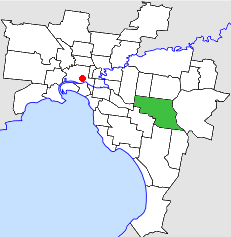City of Waverley
| City of Waverley Victoria | |||||||||||||||
|---|---|---|---|---|---|---|---|---|---|---|---|---|---|---|---|
 Location in Melbourne | |||||||||||||||
| Population | 125,400 (1992)[1] | ||||||||||||||
| • Density | 2,060.5/km2 (5,336.6/sq mi) | ||||||||||||||
| Established | 1857 | ||||||||||||||
| Area | 60.86 km2 (23.5 sq mi) | ||||||||||||||
| Council seat | Glen Waverley | ||||||||||||||
| Region | Melbourne | ||||||||||||||
| County | Bourke | ||||||||||||||
 | |||||||||||||||
| |||||||||||||||
The City of Waverley was a local government area about 20 kilometres (12 mi) east-southeast of Melbourne, the state capital of Victoria, Australia. The city covered an area of 60.86 square kilometres (23.50 sq mi), and existed from 1857 until 1994.
History
Waverley was first incorporated as the Oakleigh Road District in January 1857, which became the Shire of Oakleigh in December 1871. Parts of the Central and South Ridings were severed to create the Oakleigh Borough, which went on to become the City of Oakleigh, on 13 March 1891. The remainder was renamed the Shire of Mulgrave on 19 February 1897. In 1949 and 1959, further areas were annexed to the City of Oakleigh. On 14 April 1961, the Shire of Mulgrave became the City of Waverley.[2]
On 15 December 1994, the City of Waverley was abolished, and, along with most of the City of Oakleigh, was merged into the newly created City of Monash.[3]
Council meetings were held at Waverley Town Hall, on Springvale Road, Glen Waverley. It presently serves as the council seat for the City of Monash.
Wards
The City of Waverley was subdivided into four wards on 31 May 1971, each electing three councillors:[2]
- West Ward
- Centre Ward
- East Ward
- South Ward
Suburbs
- Ashwood
- Burwood (shared with the Cities of Box Hill and Camberwell)
- Glen Waverley
- Jordanville
- Mount Waverley
- Mulgrave
- Notting Hill
- Wheelers Hill
Population
| Year | Population |
|---|---|
| 1954 | 20,293 |
| 1958 | 39,300* |
| 1961 | 44,971 |
| 1966 | 69,832 |
| 1971 | 97,033 |
| 1976 | 117,144 |
| 1981 | 122,471 |
| 1986 | 122,935 |
| 1991 | 118,265 |
* Estimate in the 1958 Victorian Year Book.
References
- ^ Australian Bureau of Statistics, Victoria Office (1994). Victorian Year Book. p. 50. ISSN 0067-1223.
- ^ a b Victorian Municipal Directory. Brunswick: Arnall & Jackson. 1992. pp. 521–522. Accessed at State Library of Victoria, La Trobe Reading Room.
- ^ Australian Bureau of Statistics (1 August 1995). Victorian local government amalgamations 1994-1995: Changes to the Australian Standard Geographical Classification (PDF). Commonwealth of Australia. p. 9. ISBN 0-642-23117-6. Retrieved 16 December 2007.
